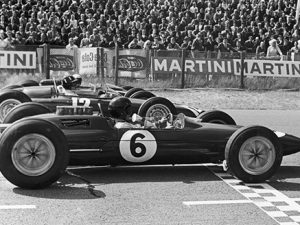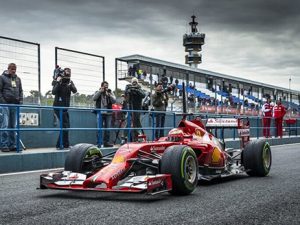Table of Contents
- The Early Years: 1950s
- Innovations and Changes: 1960s-1970s
- The Turbo Era: 1980s
- Modern F1: 1990s-Present
The Early Years: 1950s
The inaugural Formula 1 World Championship took place in 1950. The post-war era brought a surge of interest in motorsport, leading to the formation of modern F1. Nino Farina won the first ever World Championship in his Alfa Romeo. The races were dominated by Italian teams, with Alfa Romeo, Ferrari, and Maserati leading the charge. The introduction of these races heralded a new era of motor sports, drawing massive crowds and increasing international interest.
Key Milestones of the 1950s
- 1950: Introduction of the Formula 1 World Championship
- 1951: Juan Manuel Fangio enters the scene, winning multiple championships
- 1958: First Constructors’ Championship awarded
Innovations and Changes: 1960s-1970s

As technology advanced, so did Formula 1. During the 1960s and 1970s, cars became faster and safer. This period saw the introduction of innovations such as aerodynamic wings and sponsorship liveries. It was also marked by the rivalry between drivers like Graham Hill and Jackie Stewart. The mid-70s introduced turbocharged engines, setting the stage for future advancements.
Technical Innovations of the 1960s-1970s
| Year | Innovation |
|---|---|
| 1962 | First Monocoque Chassis |
| 1968 | Sponsor Ads on Cars |
| 1977 | First Turbocharged Engine in a Formula 1 car |
The Turbo Era: 1980s
The 1980s were defined by powerful turbocharged engines. This era brought about intense competition with drivers like Ayrton Senna, Alain Prost, and Nelson Piquet. The cars were faster than ever, and safety became a significant concern following several tragic accidents. The dominance of McLaren and Williams teams illustrated the importance of technological superiority in motorsport success.
Champions of the Turbo Era
- 1981: Nelson Piquet
- 1985: Alain Prost
- 1988: Ayrton Senna
Modern F1: 1990s-Present
From the 1990s to the present, F1 has seen significant regulations changes to enhance safety, maintain competitive balance, and promote sustainability. The rise of teams like Ferrari, Mercedes, and Red Bull Racing has created new legends in the sport. This era is marked by global expansion, with races held across the world, introducing F1 to millions of new fans.
Modern Drivers and Teams

Key figures in the modern era include Michael Schumacher, with his dominance in the early 2000s, and Lewis Hamilton, a contemporary legend. The sport continues to evolve with hybrid engine technology and an increasing focus on environmental sustainability.
The Evolution of Shock Absorbers: From Early Hydraulics to Modern Adaptive Dampers
Shock absorbers have come a long way since their inception in the early 20th century. What began as simple friction-based mechanisms has evolved into sophisticated adaptive systems that play a vital role in vehicle safety, comfort, and performance. In this article, we’ll trace the development of shock absorbers — from…
Winter Driving and Shock Absorbers: Why Cold Weather Matters
Driving in winter isn’t just about swapping out your tires or topping up antifreeze. One of the most overlooked — yet essential — components affected by cold weather is your shock absorbers. These critical parts of your suspension system not only contribute to ride comfort but also to vehicle control…
The Role of Shock Absorbers in Off-Road Driving: What Makes Them Different?
When it comes to off-road driving, the terrain is anything but smooth. From rocky trails and steep inclines to muddy ruts and deep potholes, every part of your vehicle’s suspension system is put to the test — especially your shock absorbers. Unlike those used in standard road cars, off-road shock…
Replacing vs. Upgrading Shock Absorbers: Which Option Is Better?
Shock absorbers play a critical role in your vehicle’s safety, handling, and ride comfort. Whether your current shocks are worn out or you’re simply aiming to improve performance, you might be wondering: Should you replace them with OEM (original equipment manufacturer) parts or upgrade to high-performance alternatives? Both options have…
Shock Absorbers and Tire Wear: How Suspension Affects Longevity
Many drivers think of tire wear as an issue related solely to alignment or tire quality. While these are important factors, suspension components, especially shock absorbers, play a vital and often overlooked role in determining how evenly — and how quickly — your tires wear out. In this article, we’ll…
Types of Shock Absorbers Explained: Hydraulic, Gas, and Adaptive Systems Compared
Shock absorbers are one of the most essential components of your vehicle’s suspension system. They don’t just smooth out the bumps in the road — they play a key role in handling, braking, tire wear, and overall driving safety. But not all shock absorbers are created equal. This article compares…
How Shock Absorbers Affect Your Car’s Fuel Efficiency: What You Need to Know
When thinking about ways to improve your car’s fuel efficiency, many drivers immediately think of maintaining proper tire pressure, choosing the right fuel, or even opting for lighter materials. However, one often-overlooked aspect of vehicle performance that can influence your fuel economy is the condition of your shock absorbers. Believe…
The Impact of Shock Absorbers on Vehicle Safety: Why They’re Essential for Your Car
When it comes to vehicle safety, many drivers may focus on elements like brakes, tires, and airbags. However, one often-overlooked but crucial component that contributes to overall safety is the shock absorber. These small but mighty parts play a significant role in keeping your vehicle stable, responsive, and safe on…
How to Choose the Right Shock Absorbers for Your Car: A Comprehensive Guide
When it comes to upgrading or maintaining your car’s suspension system, choosing the right shock absorbers is essential for ensuring both safety and performance. Whether you’re an enthusiast looking to enhance your vehicle’s handling or simply aiming for a smoother ride, understanding how to select the best shock absorbers for…
Shock absorbers for tuning: how to improve suspension and handling?
Table of Contents The Role of Shock Absorbers in Suspension Tuning Types of Shock Absorbers for Tuning Benefits of Upgraded Shock Absorbers Factors to Consider When Tuning Shock Absorbers Steps to Improve Suspension and Handling Tips for Choosing Shock Absorbers Tuning a vehicle is about optimizing performance, and one of…